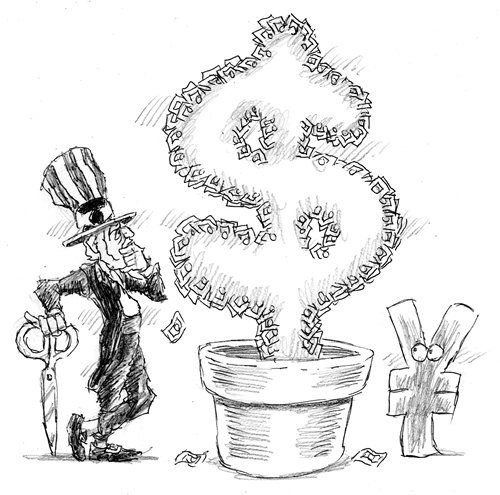
Illustration: Peter C. Espina/GT
The US Senate approved the most sweeping tax cuts in three decades in a 51-49 vote early on Saturday morning, a significant step for the Trump administration's goal of cutting taxes. As the Senate version differs slightly from that passed on November 16 by the House of Representatives, the two chambers need to reconcile their respective versions before a final bill is signed into law.
Since both versions are generally similar, there is a high probability for the cuts to become law, which would reduce taxes by about $1.4 trillion over the next 10 years, generating a strong stimulus for the US economy.
Generally speaking, the immediate impact of these sweeping changes on China will be quite limited. The long-run impact is unclear and it largely depends on what countermeasures China takes in response.
First, as for concerns over possible relocation of enterprises, it should be noted that China and the US are at different stages of development and have different labor costs. With no direct manufacturing competition, the US tax cuts will only have a relatively small direct impact on China.
Since there are treaties for avoidance of double-taxation between the US and China, some Chinese companies may consider moving to the US, where the corporate tax rate will be 20 percent. However, tax rates are just one factor companies need to consider. For instance, labor costs in the US are higher than those in China, but US workers may have higher productivity.
Other important factors include the legal environment in both countries, environmental protection requirements and the availability of upstream and downstream segments of the production chain. It is not that easy to relocate a facility to the US and start over, so no major impact is expected in the short term. But in the long run, some Chinese companies that are seriously considering moving to the US may shift some manufacturing there.
Not every industry is suitable to move to the US, and China can take steps to curb the outflow of domestic manufacturing. The US is trying to levy taxes on global profits that US companies are stashing overseas. Chinese regulators may devise similar strategies, so the impact of US tax cuts on China is uncertain in the long run.
Nevertheless, while China may inhibit the momentum of capital and manufacturing outflow through policy adjustments, such changes could have an impact on the domestic economy and taxation system.
Second, as a result of the US tax cuts and the anticipated interest rate hikes by the Federal Reserve, global capital will be attracted to the US, pushing up the value of the US dollar. In that scenario, it will be inevitable for the yuan to face great depreciation pressure against the US currency. A modest devaluation of the yuan will help China's exports. Otherwise, the yuan will have to appreciate against a basket of other currencies, which will be detrimental to the nation's exports.
Third, the US tax plan also involves individual income tax. When the tax cut is combined with US immigration reform, the country may be able to attract high-technology talent from other countries. China should guard against the possibility of a brain drain.
Last but not least, tax cuts in the world's largest economy will have a global spillover effect. While stimulating the US' economic growth and attracting capital inflows, the tax reduction plan may set off a wave of similar cuts across the world, intensifying economic competition and prompting countries to move toward a taxation and legal environment that is favorable for the most dynamic companies.
The UK, France and other European countries are reportedly working on tax-cut programs. If other developing countries also cut their corporate tax rates, China's manufacturing cost advantages will be eroded and the nation may experience outflows of high-technology talent and intellectual property. The Chinese government needs to be prepared and have comprehensive plans for all potential scenarios.


